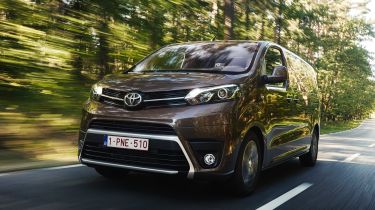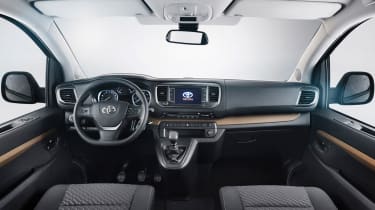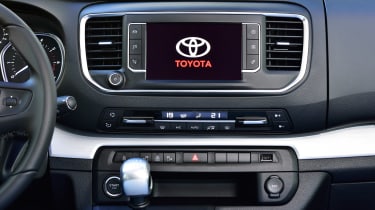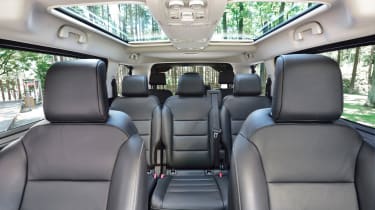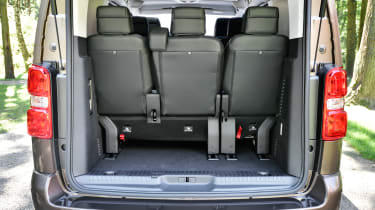Toyota Proace Verso review
Toyota's van-based MPV is more sophisticated than its workmanlike origins suggest

Toyota vacated the UK large MPV segment in 2007 when the Previa disappeared from its line-up. But today the brand once again has a solution for private individuals or businesses who want to carry a lot of people and stuff. The Toyota Proace Verso is a 6, 7, 8 or 9-seat MPV, depending on how it’s configured and, as is often the case with vehicles in this space-hungry market sector, it’s based on a van.
The Proace Verso is one of the results of a deal between Toyota and PSA Peugeot Citroen to share a mid-sized panel van platform. The other results are the Toyota Proace van, the Peugeot Expert van and the Citroen Dispatch van as well as the Peugeot Traveller and Citroen SpaceTourer people carrier versions. All these models roll off the same PSA production line in France and all the manufacturers position the MPV versions as part of their passenger car ranges.
The Proace Verso adopts the ‘Verso’ name that has been Toyota-speak for MPV for some years, just as it adopts the look, feel and technology of its French sister vehicles. Bar the badges and some slight spec differences, it’s very difficult to tell the three cars apart.
Used - available now

2022 Vauxhall
Corsa
29,832 milesManualPetrol1.2L
Cash £11,670
2022 Toyota
Aygo X
983 milesAutomaticPetrol1.0L
Cash £16,700
2018 Toyota
RAV4 Hybrid
61,790 milesAutomaticPetrol2.5L
Cash £15,395
2024 Vauxhall
Crossland
10,267 milesAutomaticPetrol1.2L
Cash £15,700• The best cars with sliding doors on sale now
Available in three sizes and three trim levels, the Toyota Proace Verso presents buyers with a useful level of choice. There are Compact, Medium and Long models with total lengths of 4,606mm, 4,856mm and 5,308mm respectively. Then you have Shuttle, Family, Family + Premium Pack and VIP trim levels, each one tailored around the wants of a different kind of buyer.
In the engine bay there’s an all-diesel line-up of 1.5 and 2.0-litre units. A 1.5-litre engine with 118bhp is joined by 148bhp and 174bhp 2.0-litre variants. The two lesser engines get six-speed manual gearboxes and the range-topper comes with a six-speed auto.
Rivals for the Toyota Proace Verso are difficult to pinpoint, mainly because the size of the smaller Compact versions means that the range straddles two market sectors. The Verso Compact could be seen as an alternative to models like the Volkswagen Caddy Life and Nissan NV200 or even Citroen’s C4 Grand SpaceTourer but larger models face off against bigger people carriers like the SEAT Alhambra and Ford Galaxy as well as van-based models like the Volkswagen Caravelle.
The Toyota Proace Verso manages to liberate a lot of space inside its van-derived body. The Compact version is one of the smallest vehicles around that can viably seat 8 adults but it only does that at the expense of any useful boot space. Higher up the range there’s room for passengers and luggage, but prices begin to creep towards those of more established rivals. The addition of the big people carrier to the Toyota range is a useful one and the Proace Verso delivers extremely well in key areas for a vehicle of this type.
Engines, performance and drive
The trick with building a passenger car on a platform designed for a van is to hide those heavy-duty commercial vehicle traits as best you can. However, the Toyota Proace Verso can actually trace its roots to PSA Group cars such as the Peugeot 308 and Citroen C4 SpaceTourer, so its commercial cousin isn’t quite as van-like in the first place. The Verso still has improved soundproofing and a smoother ride than the van, though.
Its roots do show in some areas. The suspension deals well with the smooth roads, ironing out small imperfections and remaining planted over bigger undulations, but there’s a lot of noise from the springs as they clunk over rougher surfaces and big jolts aren’t cushioned quite as well as they could be.
The steering is light, which is great in town in combination with the super-tight turning circle of the Proace Verso (just 11.3m in the smallest Compact model) but at speed the lack of feel makes it tricky to position the car accurately and constant adjustment is necessary in sweeping corners. The manual gearbox slots into position positively but it’s notchy as you move across the gate, while the brakes are a little over responsive and difficult to modulate. The firm feel of the brake pedal seems out of sync with the softness of the ones either side.
Engines
Toyota is offering the Proace Verso with a solid range of diesel engines. The entry-level unit is the 118bhp 1.5-litre. It’ll get the Verso from 0-62mph in 12 seconds and reach a 99mph top speed. If you’re heading out onto the open road, you’ll probably upgrade to the 148bhp 2.0-litre unit; 0-62mph improves to 10.3 seconds.
The final engine option is the range-topping 174bhp version of the 2.0-litre diesel engine. It’ll do 0-62mph in 8.8 seconds and comes with a 6-speed self-shifting gearbox rather than the 6-speed manual that’s the only option with the two lower-powered engines.
MPG, CO2 and Running Costs
Fuel efficiency and low emissions, with all the running costs savings they entail, are a definite strength of the Proace Verso. Its compact size compared to the majority of van-based 8-seaters helps save weight, while the PSA engines are proven to be relatively economical for a car of this size.
The smallest Compact models are available with either 2.0-litre engine; the 148bhp version returns 36.2-39.7mpg, while the more powerful 174bhp unit manages 35.3-38.6mpg. The two engines emit 142g/km and 144g/km of CO2 respectively.
Shuttle models are available in Medium and Long versions with the smallest 1.5-litre diesel engine, which returns a respectable 40.3-43.4mpg and emits 127g/km of CO2. The Medium model powered by the 148bhp diesel returns 36.2-39.2mpg.
Long models are powered exclusively by the 148bhp 2.0-litre diesel mated to an automatic gearbox; economy is rated at 36.2-38.6mpg and emissions at 145g/km.
All the engines have Stop-Start tech and are compliant with the Euro 6 emissions regulations. They have a 22.5-litre AdBlue tank to fuel a Selective Catalytic Reduction (SCR) exhaust after treatment system. The tank will need refilling approximately every 9,300 miles and this can be done via a flap in the B-pillar just inside the driver’s door.
Insurance Groups
Insurance groups for the Proace Verso have yet to be announced but one benefit of it being based on a commercial vehicle is that extra attention will have been paid to keeping the cost of repair low.
Depreciation
It’s a little early to get a firm idea of how the Toyota Proace will perform on the used market. Toyota products tend to combine a solid reputation for reliability with decent residual values but, of course, this isn’t strictly a Toyota product – the car being designed and built by PSA.
There is a precedent of sorts in the shape of the Toyota Previa, the last large Toyota MPV. That model was very popular at the time and residual values have been strong since it went off sale, possibly suggesting that the demand for Toyota-badged people carriers is there. Whether the Proace Verso can out-perform its key rival, the Volkswagen Caravelle, in terms of retained value is another matter.
Interior, design and technology
Aside from the latest Toyota family grille on the front, the Proace Verso shares its interior design with the Citroen Dispatch and Peugeot Expert.
Inside, existing Toyota owners will see even less that’s familiar as the cabin is entirely assembled using the switchgear and design cues seen on the current Peugeot and Citroen ranges. In the past, that might have been cause of concern but the French marques have noticeably upped their game in the last few years and the Verso’s cabin quality can stand comparison with anything in the mainstream large MPV class - despite its commercial vehicle roots.
The dash in the Proace Verso is effectively the same as that in the Proace van but with upgraded trim materials and some higher quality plastics. The tactile switches for the temperature controls are a highlight as is the Pro-Touch seven-inch touchscreen that’s found on Family models and above.
Sat-nav, stereo and infotainment
The entry-level Shuttle models get the unremarkable stereo system from the Proace van with its small monotone display. At least there’s smartphone integration so you can use your phone’s sat-nav, Bluetooth and a USB port.
Far better is the Toyota Pro-Touch seven-inch touchscreen that comes on stream at Family level. It’s a slick system that improves the look of the dash but, more importantly, features a DAB radio and sat-nav. As part of the Premium Pack, the Proace Verso’s stereo can be upgraded to a 10-speaker surround-sound system with a 188W amplifier and a bass box under the front passenger seat.
Practicality, comfort and boot space
The look, feel and practicality of the Proace Verso depends very much on which trim level you choose as each has been specifically tailored to cater for a different sector of the market.
The entry-level Shuttle trim is intended as a taxi or airport transfer shuttle and is only one step up from the Combi minibus model that sits in the Proace van range. It has 8 or 9 seats, the latter achieved thanks to an optional 2-person bench next to the driver - despite the fact that squeezing a paying passenger into the tight middle seat might well be a bridge too far. The back seating row can be removed for extra luggage capacity but it doesn’t slide.
The Family version is targeted at private buyers. Crucially, it gets the more flexible rail-based seating system where the 8-seat layout can be adjusted by sliding the seats back and forth or lifting them out completely. The range-toping VIP model is intended as executive transport and comes with 7 leather seats as standard. It gets rotating armchairs in the middle row and a folding table to create what Toyota calls a ‘lounge-style environment’. In all cases, lifting the seats out of the Verso is a tricky manoeuvre due to their size and weight but that tends to be the case in van-based MPVs generally.
The driving position is high by MPV standards but a little lower than other people carriers based on mid-sized vans (think Volkswagen Caravelle or Ford Tourneo Custom). It gives good visibility despite the high dash making you feel a little like your peering out through a letterbox. There’s also lots of adjustment in the driving position but we still found it oddly difficult to get comfortable.
Size
At a shade over 4.6 metres long the Compact version of the Toyota Proace Verso is suspiciously ‘compact’ for a vehicle claiming to be able to seat 8 in Family spec. For reference, a (7-seat) SEAT Alhambra is 4,854mm and the shortest (8-seat) VW Caravelle is 4,892mm.
The Compact model has a 2,925mm wheelbase but when you step up to the Medium and Long models the distance between the wheels increases to 3,275mm. These larger versions of the Proace Verso are 4,856mm and 5,308mm long respectively with the increase in the longer version achieved through an extended rear overhang.
Leg room, head room and passenger space
So to the crucial question of whether the Compact version of the Toyota Proace Verso really can seat 8. The somewhat surprising news is that it can, with a couple of caveats. Headroom is plentiful but for the legroom to be viable for adults the rear seats need to be slid right back on their runners so that there’s next to no boot space. When this is done, two trios of 6-foot tall adults can squeeze into the rear two rows without too much discomfort.
The comfort in which your passengers can sit grows as you step up the range of Proace body sizes. The Medium model is better from a legroom perspective and the Long version can get 8 in with a reasonable amount of luggage.
Access to the rear seats differs according to the Proace model you choose. In the Family and VIP versions the middle row is split 60:40 but the seats don’t tumble forwards to give access to the rear row. You have to fold the seat backs down and slide the whole seat forward on its runners – how far you can slide the seat depends on the length of the vehicle. The result in the Compact models is a very small gap for third row passengers to step through for access. Things are better in the Shuttle models that do without rail system but get middle row outer seats that tumble forwards to give easier access. At least all models get wide-opening sliding side doors, and these are electrically powered on the VIP.
Boot
Officially, the Toyota Proace Verso’s boot can hold can hold 224 litres in the Compact model, 627 litres in the Medium model and 977 litres in the Long model. Although these figures sound reasonable, it’s worth noting that this is dependant on the position of the rear seats and the space available is very tall and slim.
The actual boot floor area at your disposal is quite small with Toyota quoting a load area length of 282mm in a Family model with 8 seats occupied. Our experience is that if the 8 seats are occupied by adults with legs, you’ll probably have to half that.
If you want to carry 8 people and their luggage for more than a weekend away, you’ll only have a realistic chance in the Long version but that’s no means a unique problem to the Proace Verso. Lack of boot capacity in fully-loaded MPVs is a problem across the market.
If you take the back row of seats out or even fold the seat backs down, the Toyota becomes a hugely practical 5-seater with the three models able to carry 1,242, 1,497 and 1,847 litres respectively with the third row removed.
You also get a huge lifting tailgate on all models for easy access, you just have to make sure there’s enough space behind the vehicle to get it open. On Family spec models the tailgate glass opens separately so you can load items in the confines of a tight parking space.
Reliability and Safety
As standard, all Toyota Proace Verso models get the usual stability control and twin front airbags but there’s also hill-start assist, a tyre pressure monitoring system and cruise control with a speed limiter. As you ascend the range you can increase the airbag count up to eight and both Family and VIP models get the Toyota Safety sense pack as standard.
This package includes Adaptive Cruise Control, Forward Collision Warning, Autonomous Emergency Braking with pedestrian detection, cornering lights and a head-up display. The Verso scored 5 stars in its Euro NCAP crash test so it sets a very high standard in the safety department overall.
The Toyota Proace Verso did not feature in our Driver Power 2019 owner satisfaction survey but Toyota itself achieved a strong 10th place finish out of 30 brands. A relatively low 11.7 per cent of owners reported experiencing a fault with their cars, while running costs, fuel economy and reliability were praised. As the Verso uses running gear sourced from the PSA Group, it remains to be seen whether it can match its Japanese-built peers.
Warranty
Toyota thinks it can win sales for the Proace Verso by offering the five-year/100,000-mile warranty that’s common across its passenger car range. The mileage is unlimited in the first year too.
Servicing
Service intervals for the Proace Verso are every two years or 25,000 miles. The only exception is the 2.0-litre 174bhp models, which have their service intervals cut to every year or 20,000 miles.
